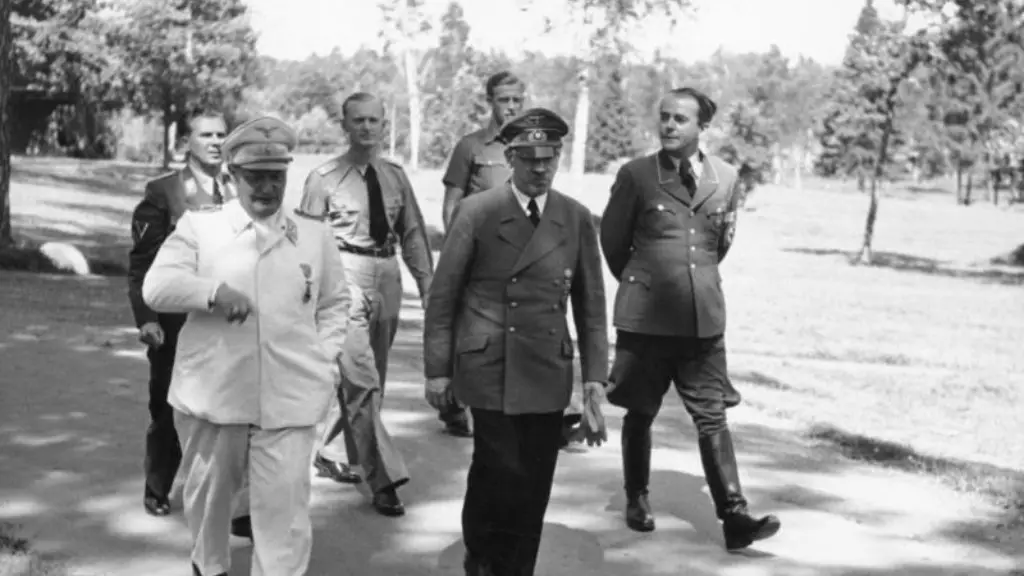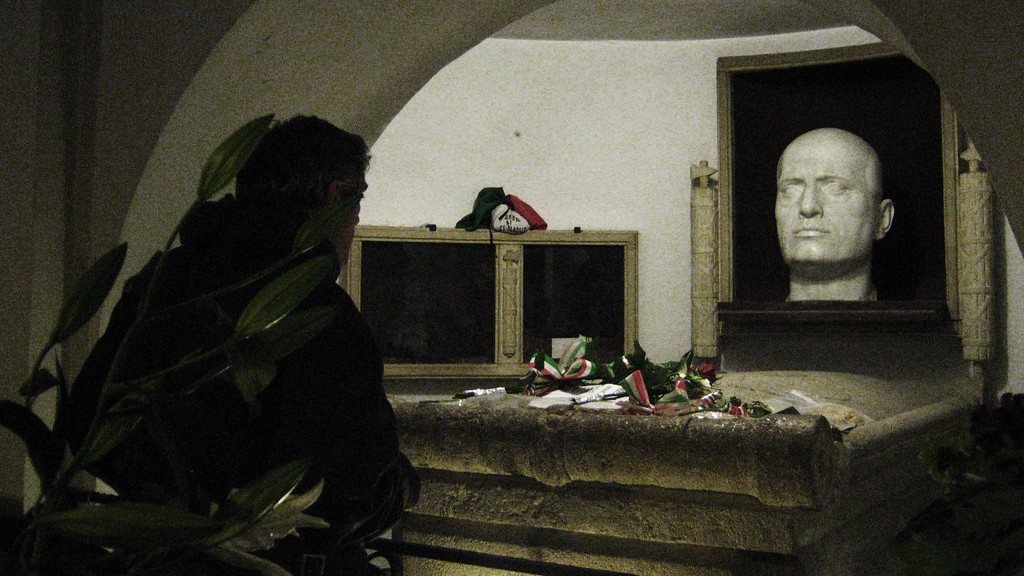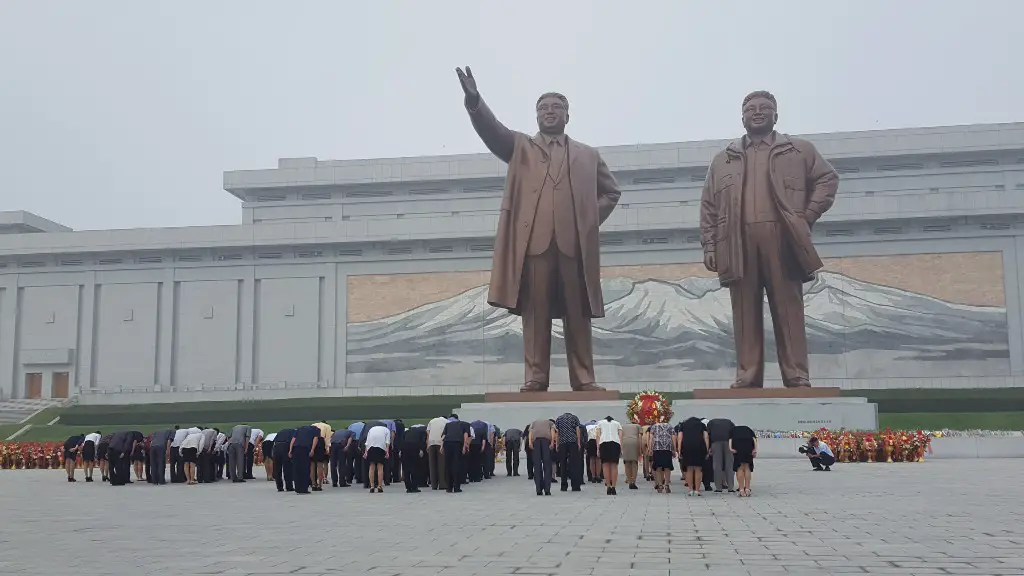Adolf Hitler was one of the most controversial leaders in history. He is known for leading Nazi Germany throughout World War II, during which he oversaw numerous atrocities such as the Holocaust. Prior to this, however, Hitler was actually born in Austria and later moved to Germany. It was here that he rose to power, firstly as the head of the Nazi Party and then as Chancellor of Germany. After a period of instability, Hitler was eventually appointed as Chancellor in 1933 by President Paul von Hindenburg. This allowed him to gain full control of the country and put into effect his totalitarian regime.
Adolf Hitler took power in Germany in 1933 by a process of slow moving takeover through legal means. Starting with his appointment as Chancellor, Hitler began to amass power to himself and his Nazi Party. He became more autocratic, suspending civil liberties and using violence and propaganda to solidify his power. A key moment came when the Nazi Party won a majority in the Reichstag, or parliament, allowing Hitler to pass the Enabling Act which gave him dictatorial powers. Hitler’s takeover was not bloodless, however, and there were some attempts to stop him through violence, such as the famous Beer Hall Putsch of 1923. In the end, though, Hitler’s careful planning and use of legal channels allowed him to become the absolute ruler of Germany.
What were Hitler’s aims when he came to power?
Adolf Hitler came to power with the goal of establishing a new racial order in Europe dominated by the German “master race”. This goal drove Nazi foreign policy, which aimed to: throw off the restrictions imposed by the Treaty of Versailles; incorporate territories with ethnic German populations into the Reich; acquire “living space” for the German people through expansion into Eastern Europe; and ultimately achieve the extermination of the Jews from Europe. Nazi foreign policy led to World War II, the devastation of much of Europe, and the death of millions, including six million Jews.
The national referendum held on August 19, 1934 confirmed Hitler as the sole Führer of Germany. All power was centralized in Hitler’s person and his word became the highest law. Nazi Germany, also known as the German Reich, was a period in German history from 1933 to 1945, characterized by totalitarianism, a single-party dictatorship, aggressive expansionism, and ultimately the devastation of World War II.
Who started World War 2
While it is true that Germany’s invasion of Poland in 1939 led to France and the United Kingdom declaring war on Germany, it is important to remember that there were a number of other factors that contributed to the outbreak of World War II. For example, the rise of Naziism in Germany, the aggressive actions of Japan in Asia, and the appeasement policies of the Western powers all played a role in the lead-up to the war.
Hitler’s ambition for territorial expansion was driven by his desire to reunify the German peoples and his pursuit of Lebensraum, “living space” that would enable Germans to become economically self-sufficient and militarily secure. Hitler’s expansionist ambitions were a major contributing factor to the outbreak of World War II.
What was Hitler’s new order?
The objective of the Nazis was to establish a post-war continental hegemony. This was to be achieved by expanding the territorial base of the German state and subjugating the rest of Europe to Germany. The Nazis believed that this would allow them to establish a New Order in Europe that would be dominated by Germany.
The years 1941 and 1942 saw the height of German success in World War II. At that time, the German army controlled an area that stretched from France to deep into Russia, and from Norway to western Egypt. However, this success was not to last, and by the end of the war, the German army had been defeated and driven out of all of its occupied territories.
When was Hitler’s first defeat?
The recapture of Narvik on 28 May 1940 was the first major defeat of the war for Nazi Germany. This defeat signaled the end of Germany’s advances in Scandinavia and forced them to focus their attention elsewhere. The Allies were able to take advantage of this defeat and use it to their advantage in the war.
This is an unconfirmed allegation, and little is known about Jean-Marie Loret. He was reportedly born in March 1918 and died in 1985, aged 67. Loret allegedly married several times and had as many as nine children. If the allegation is true, then Hitler would have been a father at the age of 29.
Who won ww2 USA or Russia
The Second World War was a conflict that was largely won by the Soviet Union. Westerners tend to see the war through the lens of events such as D-Day or the Battle of Britain, but the reality is that the Soviet Union played a much bigger role in the conflict. The Soviet Union suffered the most casualties of any country in the war, and their victory against Nazi Germany was crucial in ensuring the Allied victory.
The sneak attack on Pearl Harbor was a preventive action by Japan in order to keep the US Pacific Fleet from interfering with its upcoming military actions in Southeast Asia against the UK, Netherlands, and US territories. The attack was successful in damage done and served as a significant blow to the US Pacific Fleet.
How did WWII end?
On September 2, 1945, the United States formally accepted Japan’s surrender, marking the end of World War II. President Truman made the announcement of Japan’s surrender, and celebrations quickly erupted across America. The USS Missouri served as the site of the formal surrender documents, designating September 2 as Victory over Japan Day (V-J Day).
1. The Treaty of Versailles: The Treaty of Versailles ended World War I and imposed severe economic penalties on Germany. This treaty, along with the global economic depression, led to the rise of Adolf Hitler.
2. The Great Depression: The Great Depression was a global economic crisis that began in 1929. This economic hardship led to the rise of Adolf Hitler in Germany.
3. Adolf Hitler: Adolf Hitler was a German dictator who rose to power in 1933. Hitler’s aggressive foreign policy and expansionist ideology led to World War II.
4. Japanese Expansionism: Japanese expansionism in the 1930s led to conflict with China and ultimately to war with the United States.
5. Fascism in Italy: Fascism, a political ideology that glorifies violence and totalitarianism, rose to power in Italy in the 1920s. Italian dictator Benito Mussolini led his country into World War II.
6. Nazism: Nazism is an extreme form of fascism that rose to power in Germany in the 1930s. Nazism led to World War II through its aggressive foreign policy and expansionist ideology.
7. The Spanish Civil War: The Spanish Civil War was a conflict that pitted fascist forces against
What was Hitler’s last effort
The Battle of the Bulge was a major turning point in the European theater of World War II. Germany’s last-ditch effort to defeat the Allies in late 1944 was thwarted, ensuring the eventual Allied victory in the war. The Battle of the Bulge also signaled the beginning of the end for Nazi Germany, as the Wehrmacht was never able to fully recover from the enormous losses suffered during the battle.
1939 was a critical year in world history. The British gave Nazi dictator Adolf Hitler an ultimatum: pull out of Poland, or else Britain and France would declare war. Hitler ignored the demand, and on September 3, 1939, Britain and France declared war, setting in motion a chain of events that would lead to the Second World War.
What was Hitler’s last offensive?
The Battle of the Bulge was one of the most important battles of World War II. It was a major turning point in the war, and proved to be a decisive victory for the Allies. The battle was fought in the Ardennes region of Belgium, and was the last major offensive by Nazi Germany. It was a brutal battle, and more than 19,000 Americans were killed. But the victory was a crucial one, and helped to pave the way for the eventual defeat of Nazi Germany.
Germany’s four fatal weaknesses in the Second World War were the lack of productivity of its war economy, the weak supply lines, the start of a war on two fronts, and the lack of strong leadership. These weaknesses led to the eventual defeat of Germany in the war.
Conclusion
Adolf Hitler rose to power in Germany during the 1920s and 1930s by capitalizing on the economic and political instability of the Weimar Republic. He used his position as head of the Nazi Party to gain support from the German people and consolidate power. By 1933, Hitler had established a dictatorial regime in Germany and was well on his way to achieving his goal of world domination.
After Adolf Hitler was appointed Chancellor of Germany in 1933, he began to transform the country into a totalitarian state. He abolished the country’s democracy and instead developed a one-party dictatorship. Hitler also expanded the bureaucracy and police state in order to control the population. Lastly, he used propaganda to control the media and indoctrinate the public. These actions ultimately allowed Hitler to solidify his power and establish Nazi Germany.




